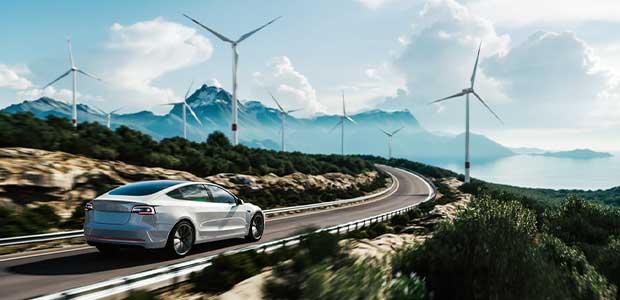
Understanding the Sustainability of Electric Cars
An introduction to sustainability within the car industry.
- By Elizabeth Long
- Jul 22, 2022
We hear a lot about sustainability—how to live more sustainably, how to make more sustainable decisions and how to buy sustainable products. But what role does sustainability play in the car industry?
Well, sustainability focuses around the idea that we need to meet our current needs without compromising the ability of future generations to do the same. This means that goods should be produced in a way that causes little (or no) damage to the environment.
We’ve seen a growing focus on sustainability across industries. It’s much easier to buy products made from recycled and/or recyclable materials, find information on where goods are sourced from, and have access to a greater choice of ethical services.
These are all things that we appreciate. An IBM study found that 57 percent of consumers are willing to change their purchasing habits to help reduce negative environmental impact. While recycling more or shopping locally are smaller decisions than purchasing a car, they are all important steps in the right direction. These changing habits signal a shift in priorities towards increasingly sustainable choices.
Experts predict that value and ease will continue to be the largest factors in buying decisions for some time, but rounding up the top three will be sustainability.
For the automotive industry, it can be a tough balancing act. But one thing is clear: sustainability is a strategic priority that’s here to stay. In a Capgemini Research Institute survey of 500 large automotive organizations, as well as 300 related experts, it was found that:
- 62 percent of automotive organizations have a comprehensive sustainability strategy with well-defined goals and targets
- 74 percent of original equipment manufacturers (OEMs) have an electric vehicle plan
- 52 percent of the organizations support and promote circular economy initiatives
How Cars Affect the Environment
It’s no secret that transport hasn’t been great for the planet. In fact, transport accounts for around one-fifth of global carbon dioxide (CO2) emissions.
Road traffic accounts for the majority of transport emissions. And the largest contributor of greenhouse gases for most cars are tailpipe emissions. These are the chemicals produced by a car with a conventional internal combustion engine as it runs, and include:
- Carbon dioxide (CO2)
- Nitrogen oxides (NOx)
- Particulate matter (PM10)
- Ozone (O3)
Over the years, there’s been plenty of initiatives to limit the effects of tailpipe emissions. These started in 1970 when the first European exhaust emissions standard for passenger cars was introduced. Not much happened until 1992 when the Euro 1 standard came along, introducing the requirement to fit catalytic converters to petrol cars to reduce carbon monoxide emissions.
We’re now on Euro 6 standards which ensure pollutants are reduced by 96 percent compared to the 1992 limits, according to the AA.
Now that we’ve left the EU, as set out in the government’s Road to Zero Strategy, they plan to pursue “a future approach as we leave the European Union, that is at least as ambitious as the current arrangements for vehicle emissions regulation.”
But it’s not just running a car which can impact the environment. There’s also the reality of demand. According to the Capgemini Research Institute report, The Automotive In the Era of Sustainability, the rate at which people buy cars continues to grow.
While initiatives such as those above have led to great improvements in the fuel efficiency of vehicles and consequently a reduction in emissions, the demand for cars is undermining any advancements. Between 2005 and 2018, 44 percent more vehicles were sold, while there’s been a 26 percent reduction in emissions per car.
Balancing Our Need for Transport
We need to get around. Cars offer us huge convenience and freedom of movement, not to mention the reality that cars are a bit of a symbol of style and status. When you’ve had your own car for years, it can be hard to imagine life without one.
When looking to make more sustainable or ethical choices, changing or ditching cars isn’t the easiest switch. When asked what would convince them to switch from their private car to alternative modes of transport, the most popular reply from the general public was “nothing.” The positive impact on the environment was only mentioned by 5 percent of respondents.
It’s clear that people are attached to their cars. And, in many cases, they are a necessity of life. If you live in more rural areas with limited or no public transport, it could be miles to the nearest shop, doctors or other amenity. It’s also not feasible for everyone to use public transport even if it is available—or example, those who rely on Motability vehicles with adaptations. Currently, people may also be cautious of public transport because of the coronavirus pandemic.
So, what’s the answer? Going forwards, electrification of vehicles has a huge role to play in tackling the impact cars have on the environment—largely because it eliminates all tailpipe emissions. Instead of burning fossil fuels for power, they harness electricity from the power grid.
There are alternatives to electric cars, such as hydrogen-powered cars, but by comparison their development and adoption is limited. The potential impact in the near future is much greater with electric cars.
About the Author
Elizabeth Long is passionate about reducing the negative impact that we have on the environment around us, and learning new ways to sustainably manage our lifestyle. Long favors data-driven articles to help illustrate the scale of the problem for a wider audience.